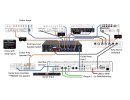Hey all. I’m Jared, from the beautiful city of Chicago. This is my first post here, because I’m considering jumping into the digital world. I’m still trying to convince myself of the last 10% in my head before pulling the trigger on an FM9, and I’m dealing with my purely emotional attachment to the “tradition” (or whatever you call it) of plugging in to a traditional tube amp and stomping on little circuit boxes. I’m asking this question in hopes it might reveal whether I can soothe a few lingering thoughts still holding me back.
This is perhaps a bit of an existential one, but I wanted to ask if you feel like you’ve been able to find “your” sound using just a Fractal rig. I ask because these devices are built to recreate iconic sounds (and do it impressively well) but a lot of my favorite players in the indie realm, who have very distinct sounds live, still haven’t moved over to them. I’m thinking the Mac Demarco, Alec O’Handley, Steve Sladkowski, etc. A lot of them are still using tube amps and pedalboards with great sounds and they have their own “flavor,” if you will. Obviously there are a lot of options and tweaking made possible with Fractal, but is generating a unique tone from scratch really all that hard with a palette of modeled classic sounds?
My follow up question is about dynamics. I saw Destroyer live tonight and the guitar player’s dynamics were so sweet and pure, like the guitar was talking and whispering in some parts. Is that kind of subtlety possible on an FM9 rig? That sort of “raw” feeling where you can seemingly hear people’s fingerprints on the strings?
Thanks all. One of these units is the most logical, rational, and—despite initial costs—economical choice for me, but I don’t know anyone in town playing one and I didn’t like the Helix Stomp I tried last year, so I’m still hung up on a couple things. I welcome a push over the “buy it” line and any examples or references you might be able to share.
Cheers!
This is perhaps a bit of an existential one, but I wanted to ask if you feel like you’ve been able to find “your” sound using just a Fractal rig. I ask because these devices are built to recreate iconic sounds (and do it impressively well) but a lot of my favorite players in the indie realm, who have very distinct sounds live, still haven’t moved over to them. I’m thinking the Mac Demarco, Alec O’Handley, Steve Sladkowski, etc. A lot of them are still using tube amps and pedalboards with great sounds and they have their own “flavor,” if you will. Obviously there are a lot of options and tweaking made possible with Fractal, but is generating a unique tone from scratch really all that hard with a palette of modeled classic sounds?
My follow up question is about dynamics. I saw Destroyer live tonight and the guitar player’s dynamics were so sweet and pure, like the guitar was talking and whispering in some parts. Is that kind of subtlety possible on an FM9 rig? That sort of “raw” feeling where you can seemingly hear people’s fingerprints on the strings?
Thanks all. One of these units is the most logical, rational, and—despite initial costs—economical choice for me, but I don’t know anyone in town playing one and I didn’t like the Helix Stomp I tried last year, so I’m still hung up on a couple things. I welcome a push over the “buy it” line and any examples or references you might be able to share.
Cheers!



